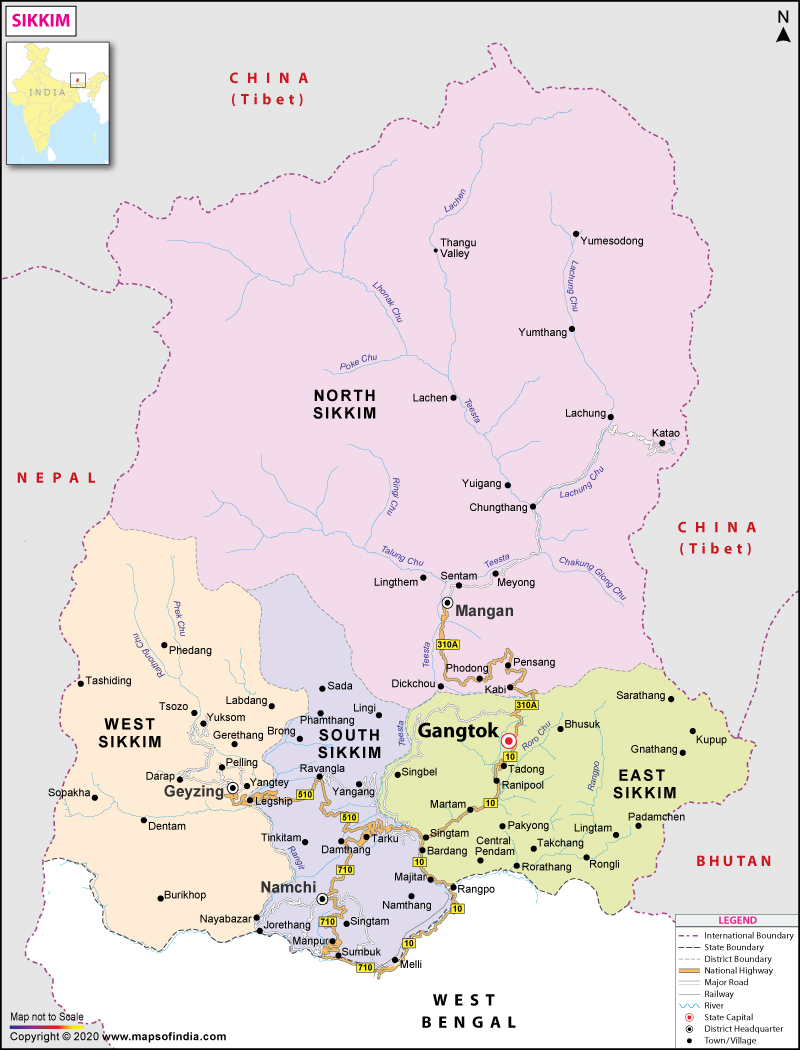Important Facts For Prelims
50th Anniversary of Sikkim’s Integration with India
- 02 Jun 2025
- 6 min read
Why in News?
The Prime Minister congratulated Sikkim on the 50th anniversary of its integration into the Indian Union, marking its official recognition as the 22nd state of India on 16th May 1975.
What are the Key Facts About Sikkim’s Integration with India?
- Monarchical Background: Sikkim was a hereditary monarchy ruled by the Chogyal dynasty from 1642 to 1975.
- Sikkim’s Autonomy: It maintained its autonomy during British colonial rule and post Indian independence through:
- Treaty of Tumlong (1861): Sikkim became a protectorate state of British India.
- Treaty of Titaliya (1817): It gave the British authorities several commercial and political advantages in Sikkim.
- Calcutta Convention (1890): It demarcated the Sikkim-Tibet border, signed by Viceroy Lord Lansdowne and Qing China's Imperial Associate Resident in Tibet.
- The Convention was affirmed by the Lhasa Convention (1904).
- Indo-Sikkim Treaty (1950): It made Sikkim an Indian protectorate, with India controlling defence, external affairs, and communication, while Sikkim retained internal autonomy.
- Merger with India: In 1975, a referendum saw participation from two-thirds of eligible voters, with 97% voting to abolish the monarchy and join India.
- 35th Amendment Act, 1974: The status of Sikkim as a protectorate state was terminated and Sikkim was given the status of 'Associate State' of India.
- 36th Amendment Act, 1975: It made Sikkim a full-fledged state in India.
What are Key Facts About Sikkim?
- About: Sikkim is the smallest state after Goa and is situated in the northeastern part of India in the eastern Himalayas.
- It shares borders with the Tibet Autonomous Region of China to the north and northeast, Bhutan to the southeast, the Indian state of West Bengal to the south, and Nepal to the west.
- New Developments: Soreng district in Sikkim will be developed as India’s first organic fishery cluster. To boost tourism, the Pelling Ropeway was inaugurated as part of efforts to make Sikkim a global tourism hub.
- Notably, Sikkim became the world’s first fully organic state in 2016.
- Geography:
- Mountains: Mount Kanchenjunga, India’s highest peak and the world’s third highest mountain lies in Sikkim.
- Rivers: Sikkim is drained by the Teesta river and its tributaries such as the Rangit, Lhonak, Talung and Lachung. Teesta river is a tributary of Brahmaputra river.
- Teesta river water conflict is one of the most contentious issues between India and Bangladesh.
- Glaciers: Zemu glacier, Lhonak glacier, Changsang glacier, Boktok glacier etc.
- Lakes: Tsomgo Lake (Changu Lake), Menmecho lake, Bidang Cho lake, Gurudongmar lake etc.
- Passes: Nathu La, Jelep La, Dongkha La, Chiwabhanjang Pass.
- Biodiversity: Sikkim covering just 0.2 % of the geographical area of the country has tremendous biodiversity and has been identified as one of the Hotspot in the Eastern Himalayas.
- Flora: Oaks, Chestnuts, Rhododendrons, Magnolias, Japanese Cedar, Toona, Castanopsis etc.
- Fauna: Himalayan squirrel, Large palm civet, Yellow-throated martens, Flying squirrels, Bar-headed geese, Indian tortoiseshell, Golden sapphire, Red panda, Blue Sheep, Gorals, Tibetan antelope.
- Protected Areas: Kanchenjunga National Park (World Heritage Site (2016), Biosphere Reserve (2018)), Fambong Lho Sanctuary, Varsey Rhododendron Sanctuary, Maenam Sanctuary, Pangolakha Wildlife Sanctuary etc.
UPSC Civil Services Examination, Previous Year Question
Q. Consider the following pairs (2019)
Glacier River
- Bandarpunch : Yamuna
- Bara Shigri : Chenab
- Milam : Mandakini
- Siachen : Nubra
- Zemu : Manas
Which of the pairs given above are correctly matched?
(a) 1, 2 and 4
(b) 1, 3 and 4
(c) 2 and 5
(d) 3 and 5
Ans: (a)
Q. With reference to river Teesta, consider the following statements: (2017)
- The source of river Teesta is the same as that of Brahmaputra but it flows through Sikkim.
- River Rangeet originates in Sikkim and it is a tributary of river Teesta.
- River Teesta flows into Bay of Bengal on the border of India and Bangladesh.
Which of the statements given above is/are correct?
(a) 1 and 3 only
(b) 2 only
(c) 2 and 3 only
(d) 1, 2 and 3
Ans: (b)







